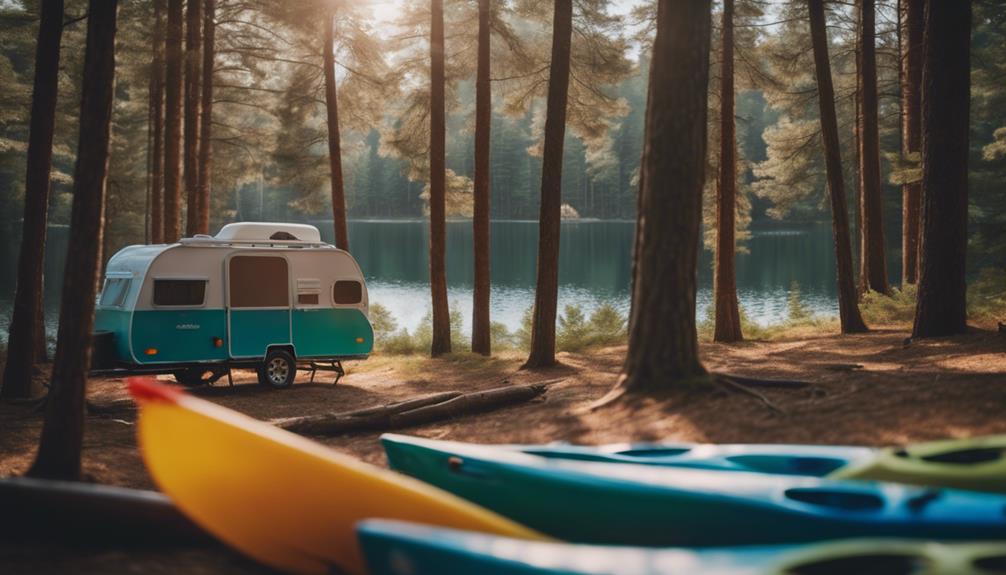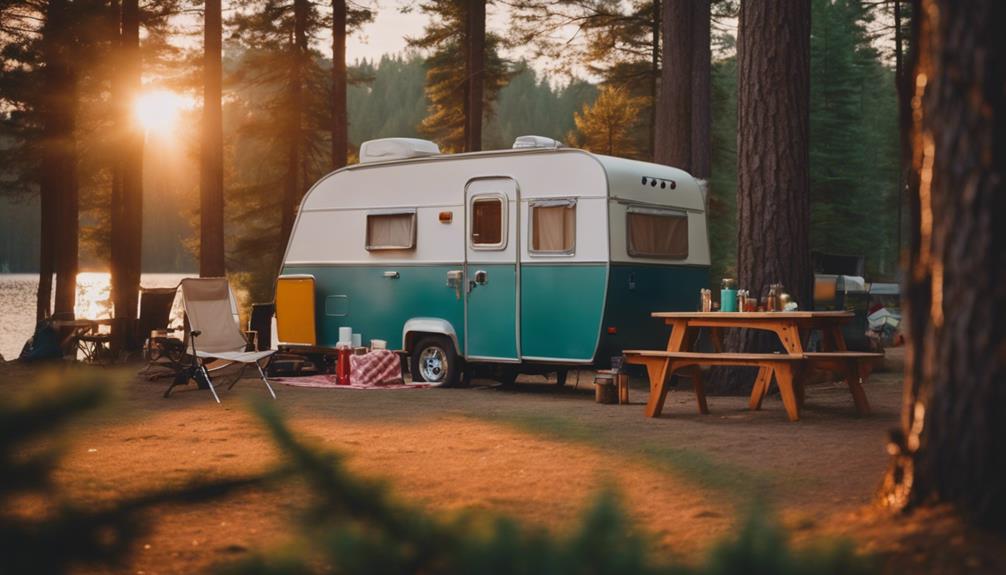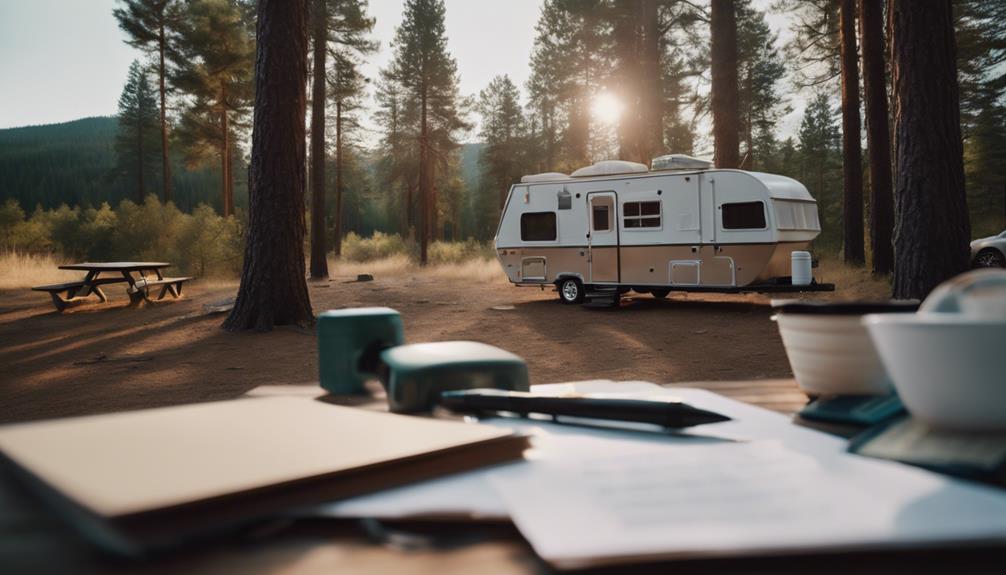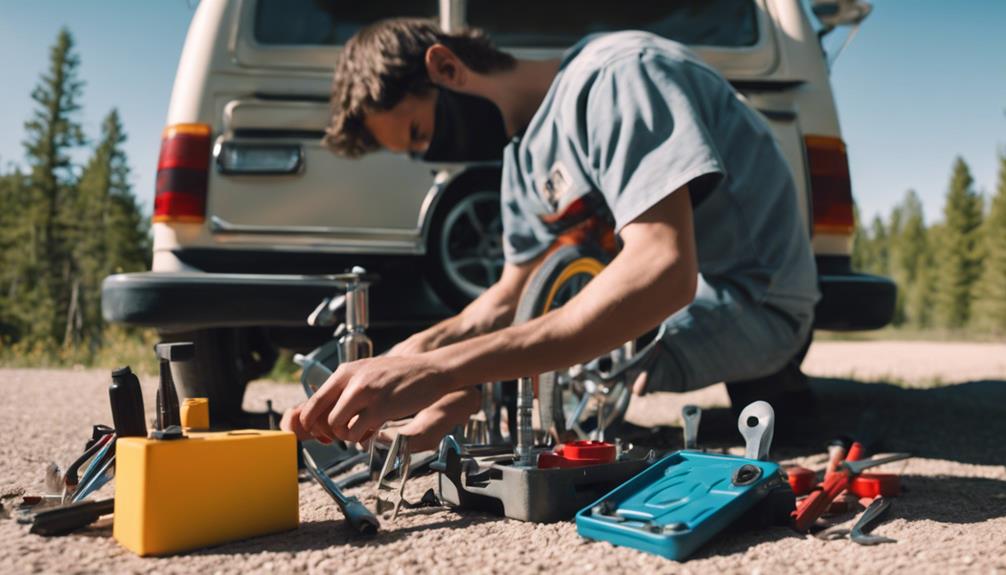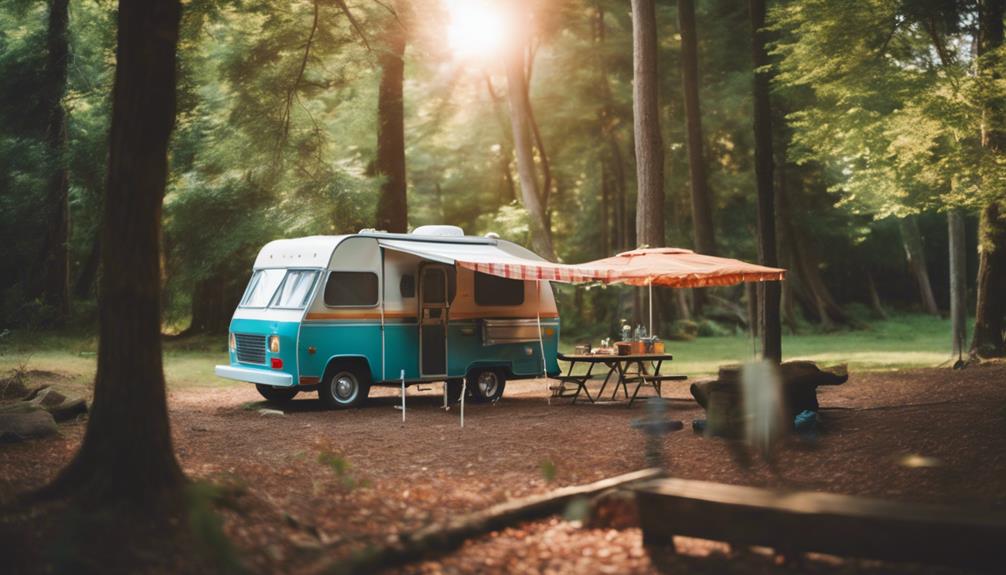To mount kayaks on your pop-up camper, start by evaluating the roof structure for load capacity and any damage. Choose a compatible rack system that fits your camper and kayaks securely. Load the heaviest kayak first, centered, and make sure all kayaks are hull-side down to reduce wind resistance. Use durable straps or bungee cords to tightly secure them, and add foam padding to protect the surface. Finally, inspect everything regularly for wear and make sure all straps are tight before hitting the road. You'll find even more helpful tips for trouble-free adventures as you explore further.
Key Takeaways
- Verify the roof load capacity and inspect for any existing damage before mounting kayaks.
- Choose a compatible rack system designed for camper roofs that securely holds the desired number of kayaks.
- Load the heaviest kayak first, ensuring it is centered and hull-facing down for stability and wind resistance.
- Secure kayaks with durable straps or bungee cords, and consider adding foam padding to prevent scratches.
Assessing Roof Structure
Before you mount kayaks on your pop-up camper, it's important to assess the roof structure to confirm it can safely support their weight.
First, make sure to check the manufacturer's specifications for the roof load capacity. This information is significant, as exceeding this limit can lead to serious structural damage or safety hazards during your travels.
Next, inspect the roof for any existing damage or weak points. Pay close attention to areas that may be vulnerable, as the added weight of the kayaks can exacerbate these issues. If you notice any concerns, consider repairing them before proceeding.
Additionally, think about using roof racks specifically designed for camper roofs. These racks can help distribute the weight more evenly and provide secure mounting points for the kayaks. Make sure the mounting system you choose allows for easy loading and unloading, which is crucial for convenience and efficiency.
Lastly, maintain a low center of gravity when mounting the kayaks, as this will help prevent tipping while driving. By taking these steps, you'll guarantee a safer and more enjoyable adventure with your kayaks.
Choosing the Right Rack System
Choosing the right rack system is essential for safely transporting your kayaks on a pop-up camper, as it directly affects stability and ease of access.
Start by selecting a rack that accommodates the number of kayaks you plan to transport. For instance, a trailer with racks designed for three kayaks can optimize space and balance during travel. Make certain the rack system is compatible with your camper's design and weight capacity to prevent damage and enhance stability on the road.
Consider adjustable or removable rack systems for flexibility, allowing you to configure the setup based on your kayaking gear and trip requirements. When choosing a rack, look for secure mounting options, such as straps or tie-downs, to prevent movement or damage to the kayaks during transportation.
Evaluate how easy it is to load and unload your kayaks, as this can considerably impact your trip preparation and overall experience.
Lastly, always double-check the entire system once it's set up, making sure everything is secure before hitting the road. This attention to detail will guarantee a smooth and enjoyable kayaking adventure.
Loading and Balancing Kayaks
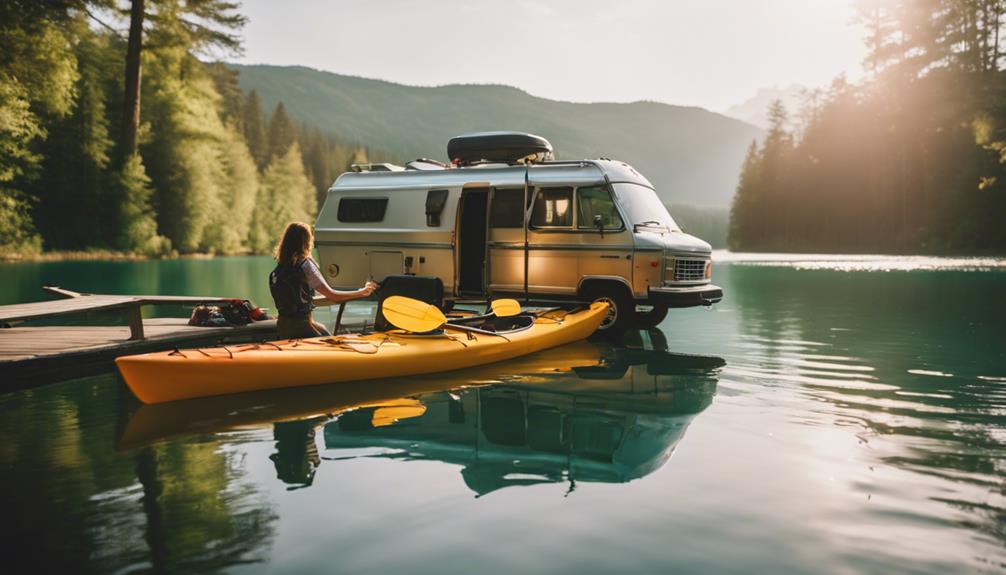
Loading and balancing your kayaks properly is vital for a safe and enjoyable trip on your pop-up camper. Start by confirming your trailer is equipped with racks that can hold three kayaks while distributing their weight evenly. Load the heaviest kayak first, ideally centered on the rack. This lowers the center of gravity and enhances stability during transport.
When loading, make certain to position the kayaks with their hulls facing down. This orientation minimizes wind resistance and potential damage. Use bungee cords or straps to secure the kayaks tightly, preventing any movement while you're driving. It's critical they aren't too loose, as this can cause swaying, which could affect your overall driving safety.
After loading, don't forget to conduct a final inspection. Check that all equipment, including paddles and life jackets, is securely stored in the designated storage box to prevent shifting. It's also wise to verify you have a spare tire on hand when you hit the road, just in case you encounter any issues.
With careful loading and balancing, you can focus on enjoying your adventure!
Securing Your Kayaks
Once your kayaks are loaded and balanced, securing them properly is key to guaranteeing they stay in place during your journey. Start by using durable straps or bungee cords to tightly fasten the kayaks to the trailer racks. Make sure the heaviest kayak is at the bottom, as this helps prevent swaying during transport.
Consider adding foam padding at the contact points to avoid scratches and damage. It's also essential to regularly check the tightness of your straps, especially after long stops, to make certain the kayaks remain securely mounted. Finally, for added peace of mind, use a locking system or cable to deter theft when your kayaks are unattended.
Here's a quick reference table to help you remember these tips:
| Action | Description | Importance |
|---|---|---|
| Use Durable Straps | Secure kayaks tightly to the trailer racks | Prevents shifting |
| Check Strap Tightness | Regularly verify straps are tight | Increases safety |
| Add Foam Padding | Protect contact points between kayaks and racks | Prevents scratches and damage |
Next time you hit the road, keep these securing tips in mind for a stress-free adventure!
Regular Maintenance Checks

Regular maintenance checks are essential to guarantee your kayak mounting system remains safe and functional for every trip.
Start by inspecting the entire kayak mounting system on your pop-up camper for any signs of wear or damage. Before each outing, make sure all straps and supports are secure, focusing on both the front and back of the setup.
Check that your kayaks are properly balanced on the trailer to prevent swaying during transport, as this can lead to structural stress on both the kayaks and the camper. Look closely at the foam blocks and bungee systems used to secure the kayaks; they should be intact and functioning correctly to provide essential stability.
Don't neglect to periodically examine the trailer's racks for rust or corrosion, especially after exposure to water, to maintain the longevity and safety of your kayak transport setup.
Frequently Asked Questions
Can You Carry a Kayak on a Pop up Camper?
Yes, you can carry a kayak on a pop-up camper. Just install a sturdy rack, secure the kayaks with straps, and check the weight limits. Regularly inspect everything to guarantee a safe journey.
How Do You Attach a Kayak to a Camper?
To attach a kayak to your camper, secure it with adjustable straps or tie-downs. Make sure the hull faces up, and consider using foam pads to protect both the kayak and the camper during transport.
Where Do You Put the Level on a Pop up Camper?
To level your pop-up camper, place the level on a flat surface inside, like the floor or countertop. Make sure the bubble's centered. You might also check the roof for side-to-side leveling accuracy.
Does a Pop up Camper Have to Be Perfectly Level?
No, a pop-up camper doesn't have to be perfectly level, but aiming for close to level is wise. It enhances drainage and stability, ensuring your appliances work efficiently and your camping experience remains comfortable and safe.
Can the Same Method Used to Secure Bikes to a Pop-Up Camper Be Used for Mounting Kayaks?
When it comes to strapping bikes to camper, the same method may not be ideal for mounting kayaks. Bikes require secure vertical storage while kayaks need horizontal support. Consider investing in separate mounting systems for each to ensure the safety of both your bikes and kayaks during travel.
Conclusion
Now that you know how to mount kayaks on your pop-up camper, you're ready for your next adventure!
Did you know that over 30 million Americans go kayaking each year? With the right setup, you can join them and explore beautiful waterways.
Just remember to regularly check your equipment and secure your kayaks properly.
So load up, hit the road, and enjoy the thrill of paddling in new places! Adventure awaits!

